Corporate Law Assignment: Corporate Governance and Dreamworld Accident
VerifiedAdded on 2019/11/25
|10
|2475
|143
Report
AI Summary
This report analyzes a corporate law assignment focusing on the Dreamworld incident and the subsequent failures in corporate governance by Ardent Leisure. It examines the application of ASX Corporate Governance Council principles, particularly Principle 7 regarding risk management, and assesses whether Ardent Leisure recognized and managed the risks associated with the Dreamworld incident. The report delves into the potential breaches of directorial duties under section 180 of the Corporations Act 2001 (Cth) and the implications of the company's actions, including the failure to establish a crisis management team and the lack of disclosure of environmental, social, and economic risks. The analysis covers the consequences faced by Ardent Leisure, including financial and reputational losses, and the potential disciplinary actions the ASX could take. Furthermore, the report investigates whether the company conducted a review and attempted to improve the effectiveness of its risk management framework, highlighting the company's responses and the steps taken to address the incident's aftermath, ultimately concluding on the importance of robust corporate governance practices.
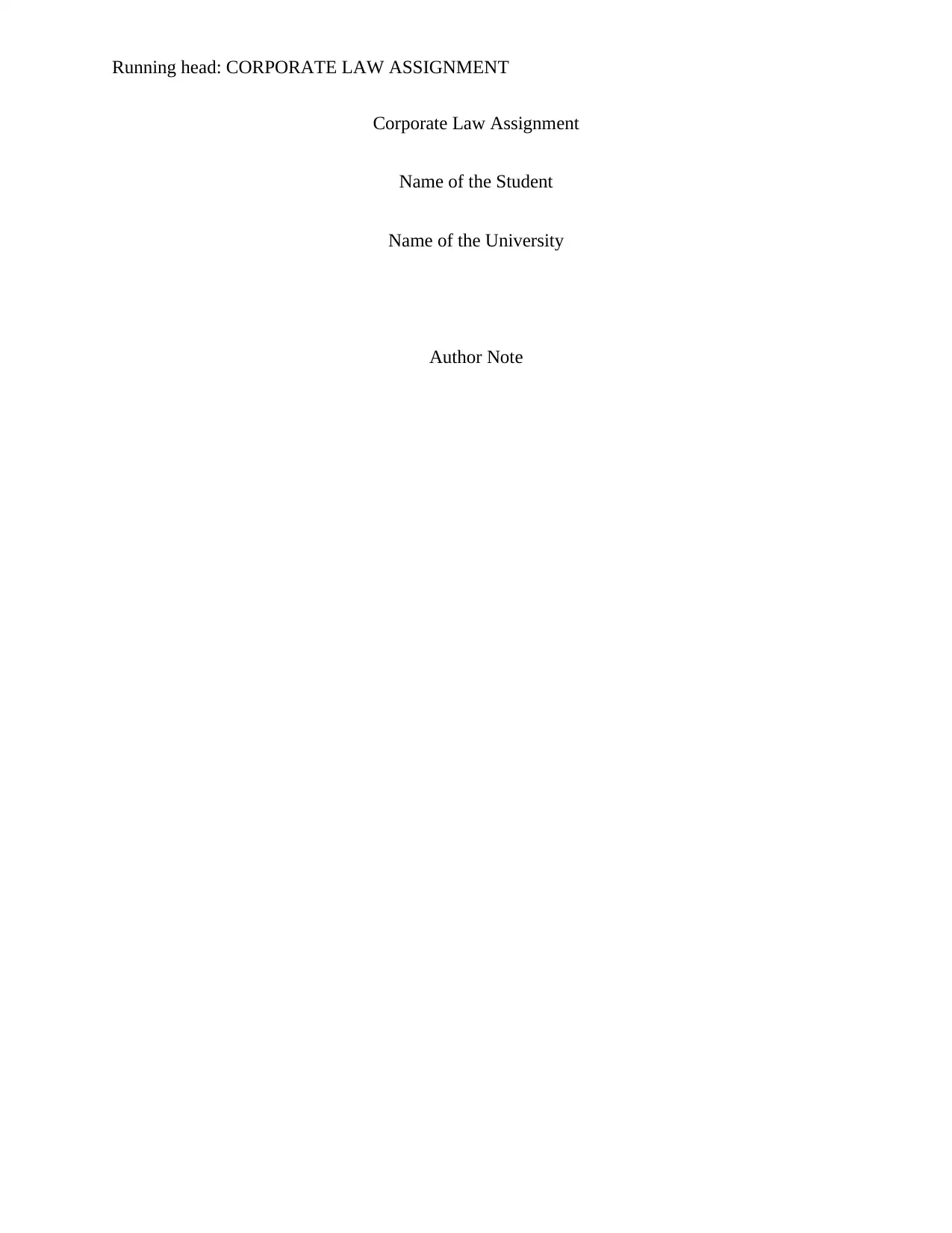
Running head: CORPORATE LAW ASSIGNMENT
Corporate Law Assignment
Name of the Student
Name of the University
Author Note
Corporate Law Assignment
Name of the Student
Name of the University
Author Note
Paraphrase This Document
Need a fresh take? Get an instant paraphrase of this document with our AI Paraphraser
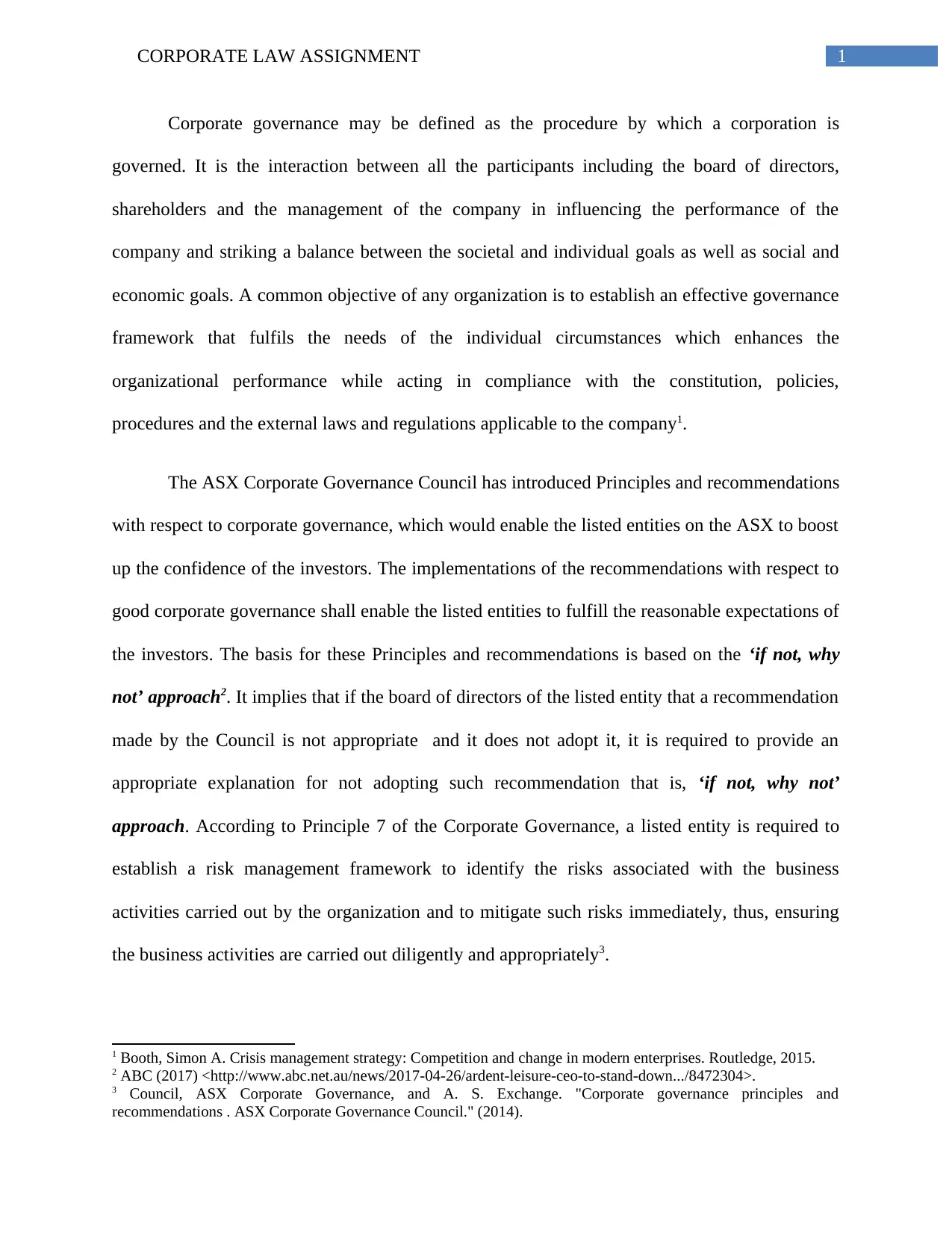
1CORPORATE LAW ASSIGNMENT
Corporate governance may be defined as the procedure by which a corporation is
governed. It is the interaction between all the participants including the board of directors,
shareholders and the management of the company in influencing the performance of the
company and striking a balance between the societal and individual goals as well as social and
economic goals. A common objective of any organization is to establish an effective governance
framework that fulfils the needs of the individual circumstances which enhances the
organizational performance while acting in compliance with the constitution, policies,
procedures and the external laws and regulations applicable to the company1.
The ASX Corporate Governance Council has introduced Principles and recommendations
with respect to corporate governance, which would enable the listed entities on the ASX to boost
up the confidence of the investors. The implementations of the recommendations with respect to
good corporate governance shall enable the listed entities to fulfill the reasonable expectations of
the investors. The basis for these Principles and recommendations is based on the ‘if not, why
not’ approach2. It implies that if the board of directors of the listed entity that a recommendation
made by the Council is not appropriate and it does not adopt it, it is required to provide an
appropriate explanation for not adopting such recommendation that is, ‘if not, why not’
approach. According to Principle 7 of the Corporate Governance, a listed entity is required to
establish a risk management framework to identify the risks associated with the business
activities carried out by the organization and to mitigate such risks immediately, thus, ensuring
the business activities are carried out diligently and appropriately3.
1 Booth, Simon A. Crisis management strategy: Competition and change in modern enterprises. Routledge, 2015.
2 ABC (2017) <http://www.abc.net.au/news/2017-04-26/ardent-leisure-ceo-to-stand-down.../8472304>.
3 Council, ASX Corporate Governance, and A. S. Exchange. "Corporate governance principles and
recommendations . ASX Corporate Governance Council." (2014).
Corporate governance may be defined as the procedure by which a corporation is
governed. It is the interaction between all the participants including the board of directors,
shareholders and the management of the company in influencing the performance of the
company and striking a balance between the societal and individual goals as well as social and
economic goals. A common objective of any organization is to establish an effective governance
framework that fulfils the needs of the individual circumstances which enhances the
organizational performance while acting in compliance with the constitution, policies,
procedures and the external laws and regulations applicable to the company1.
The ASX Corporate Governance Council has introduced Principles and recommendations
with respect to corporate governance, which would enable the listed entities on the ASX to boost
up the confidence of the investors. The implementations of the recommendations with respect to
good corporate governance shall enable the listed entities to fulfill the reasonable expectations of
the investors. The basis for these Principles and recommendations is based on the ‘if not, why
not’ approach2. It implies that if the board of directors of the listed entity that a recommendation
made by the Council is not appropriate and it does not adopt it, it is required to provide an
appropriate explanation for not adopting such recommendation that is, ‘if not, why not’
approach. According to Principle 7 of the Corporate Governance, a listed entity is required to
establish a risk management framework to identify the risks associated with the business
activities carried out by the organization and to mitigate such risks immediately, thus, ensuring
the business activities are carried out diligently and appropriately3.
1 Booth, Simon A. Crisis management strategy: Competition and change in modern enterprises. Routledge, 2015.
2 ABC (2017) <http://www.abc.net.au/news/2017-04-26/ardent-leisure-ceo-to-stand-down.../8472304>.
3 Council, ASX Corporate Governance, and A. S. Exchange. "Corporate governance principles and
recommendations . ASX Corporate Governance Council." (2014).
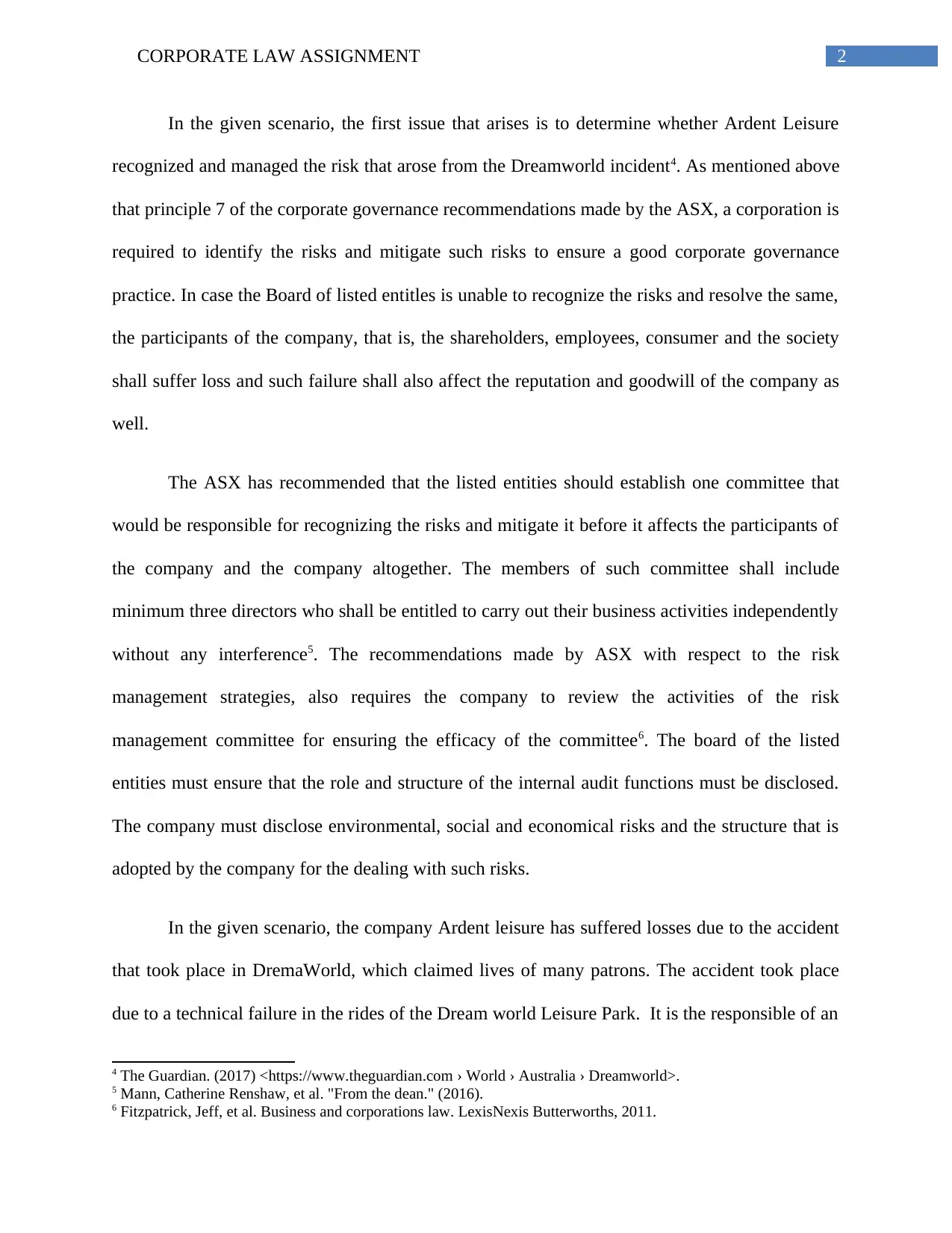
2CORPORATE LAW ASSIGNMENT
In the given scenario, the first issue that arises is to determine whether Ardent Leisure
recognized and managed the risk that arose from the Dreamworld incident4. As mentioned above
that principle 7 of the corporate governance recommendations made by the ASX, a corporation is
required to identify the risks and mitigate such risks to ensure a good corporate governance
practice. In case the Board of listed entitles is unable to recognize the risks and resolve the same,
the participants of the company, that is, the shareholders, employees, consumer and the society
shall suffer loss and such failure shall also affect the reputation and goodwill of the company as
well.
The ASX has recommended that the listed entities should establish one committee that
would be responsible for recognizing the risks and mitigate it before it affects the participants of
the company and the company altogether. The members of such committee shall include
minimum three directors who shall be entitled to carry out their business activities independently
without any interference5. The recommendations made by ASX with respect to the risk
management strategies, also requires the company to review the activities of the risk
management committee for ensuring the efficacy of the committee6. The board of the listed
entities must ensure that the role and structure of the internal audit functions must be disclosed.
The company must disclose environmental, social and economical risks and the structure that is
adopted by the company for the dealing with such risks.
In the given scenario, the company Ardent leisure has suffered losses due to the accident
that took place in DremaWorld, which claimed lives of many patrons. The accident took place
due to a technical failure in the rides of the Dream world Leisure Park. It is the responsible of an
4 The Guardian. (2017) <https://www.theguardian.com › World › Australia › Dreamworld>.
5 Mann, Catherine Renshaw, et al. "From the dean." (2016).
6 Fitzpatrick, Jeff, et al. Business and corporations law. LexisNexis Butterworths, 2011.
In the given scenario, the first issue that arises is to determine whether Ardent Leisure
recognized and managed the risk that arose from the Dreamworld incident4. As mentioned above
that principle 7 of the corporate governance recommendations made by the ASX, a corporation is
required to identify the risks and mitigate such risks to ensure a good corporate governance
practice. In case the Board of listed entitles is unable to recognize the risks and resolve the same,
the participants of the company, that is, the shareholders, employees, consumer and the society
shall suffer loss and such failure shall also affect the reputation and goodwill of the company as
well.
The ASX has recommended that the listed entities should establish one committee that
would be responsible for recognizing the risks and mitigate it before it affects the participants of
the company and the company altogether. The members of such committee shall include
minimum three directors who shall be entitled to carry out their business activities independently
without any interference5. The recommendations made by ASX with respect to the risk
management strategies, also requires the company to review the activities of the risk
management committee for ensuring the efficacy of the committee6. The board of the listed
entities must ensure that the role and structure of the internal audit functions must be disclosed.
The company must disclose environmental, social and economical risks and the structure that is
adopted by the company for the dealing with such risks.
In the given scenario, the company Ardent leisure has suffered losses due to the accident
that took place in DremaWorld, which claimed lives of many patrons. The accident took place
due to a technical failure in the rides of the Dream world Leisure Park. It is the responsible of an
4 The Guardian. (2017) <https://www.theguardian.com › World › Australia › Dreamworld>.
5 Mann, Catherine Renshaw, et al. "From the dean." (2016).
6 Fitzpatrick, Jeff, et al. Business and corporations law. LexisNexis Butterworths, 2011.
⊘ This is a preview!⊘
Do you want full access?
Subscribe today to unlock all pages.

Trusted by 1+ million students worldwide
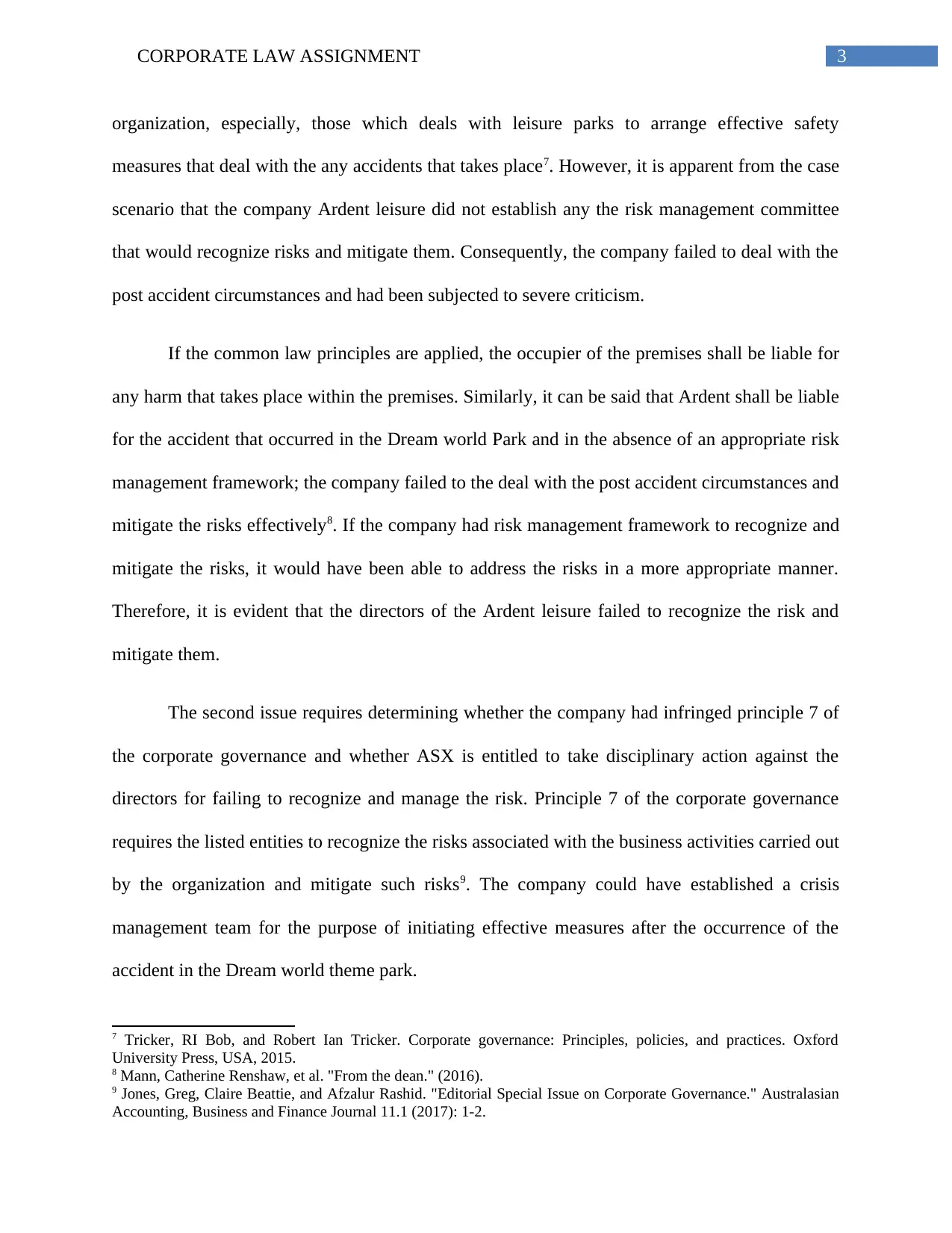
3CORPORATE LAW ASSIGNMENT
organization, especially, those which deals with leisure parks to arrange effective safety
measures that deal with the any accidents that takes place7. However, it is apparent from the case
scenario that the company Ardent leisure did not establish any the risk management committee
that would recognize risks and mitigate them. Consequently, the company failed to deal with the
post accident circumstances and had been subjected to severe criticism.
If the common law principles are applied, the occupier of the premises shall be liable for
any harm that takes place within the premises. Similarly, it can be said that Ardent shall be liable
for the accident that occurred in the Dream world Park and in the absence of an appropriate risk
management framework; the company failed to the deal with the post accident circumstances and
mitigate the risks effectively8. If the company had risk management framework to recognize and
mitigate the risks, it would have been able to address the risks in a more appropriate manner.
Therefore, it is evident that the directors of the Ardent leisure failed to recognize the risk and
mitigate them.
The second issue requires determining whether the company had infringed principle 7 of
the corporate governance and whether ASX is entitled to take disciplinary action against the
directors for failing to recognize and manage the risk. Principle 7 of the corporate governance
requires the listed entities to recognize the risks associated with the business activities carried out
by the organization and mitigate such risks9. The company could have established a crisis
management team for the purpose of initiating effective measures after the occurrence of the
accident in the Dream world theme park.
7 Tricker, RI Bob, and Robert Ian Tricker. Corporate governance: Principles, policies, and practices. Oxford
University Press, USA, 2015.
8 Mann, Catherine Renshaw, et al. "From the dean." (2016).
9 Jones, Greg, Claire Beattie, and Afzalur Rashid. "Editorial Special Issue on Corporate Governance." Australasian
Accounting, Business and Finance Journal 11.1 (2017): 1-2.
organization, especially, those which deals with leisure parks to arrange effective safety
measures that deal with the any accidents that takes place7. However, it is apparent from the case
scenario that the company Ardent leisure did not establish any the risk management committee
that would recognize risks and mitigate them. Consequently, the company failed to deal with the
post accident circumstances and had been subjected to severe criticism.
If the common law principles are applied, the occupier of the premises shall be liable for
any harm that takes place within the premises. Similarly, it can be said that Ardent shall be liable
for the accident that occurred in the Dream world Park and in the absence of an appropriate risk
management framework; the company failed to the deal with the post accident circumstances and
mitigate the risks effectively8. If the company had risk management framework to recognize and
mitigate the risks, it would have been able to address the risks in a more appropriate manner.
Therefore, it is evident that the directors of the Ardent leisure failed to recognize the risk and
mitigate them.
The second issue requires determining whether the company had infringed principle 7 of
the corporate governance and whether ASX is entitled to take disciplinary action against the
directors for failing to recognize and manage the risk. Principle 7 of the corporate governance
requires the listed entities to recognize the risks associated with the business activities carried out
by the organization and mitigate such risks9. The company could have established a crisis
management team for the purpose of initiating effective measures after the occurrence of the
accident in the Dream world theme park.
7 Tricker, RI Bob, and Robert Ian Tricker. Corporate governance: Principles, policies, and practices. Oxford
University Press, USA, 2015.
8 Mann, Catherine Renshaw, et al. "From the dean." (2016).
9 Jones, Greg, Claire Beattie, and Afzalur Rashid. "Editorial Special Issue on Corporate Governance." Australasian
Accounting, Business and Finance Journal 11.1 (2017): 1-2.
Paraphrase This Document
Need a fresh take? Get an instant paraphrase of this document with our AI Paraphraser
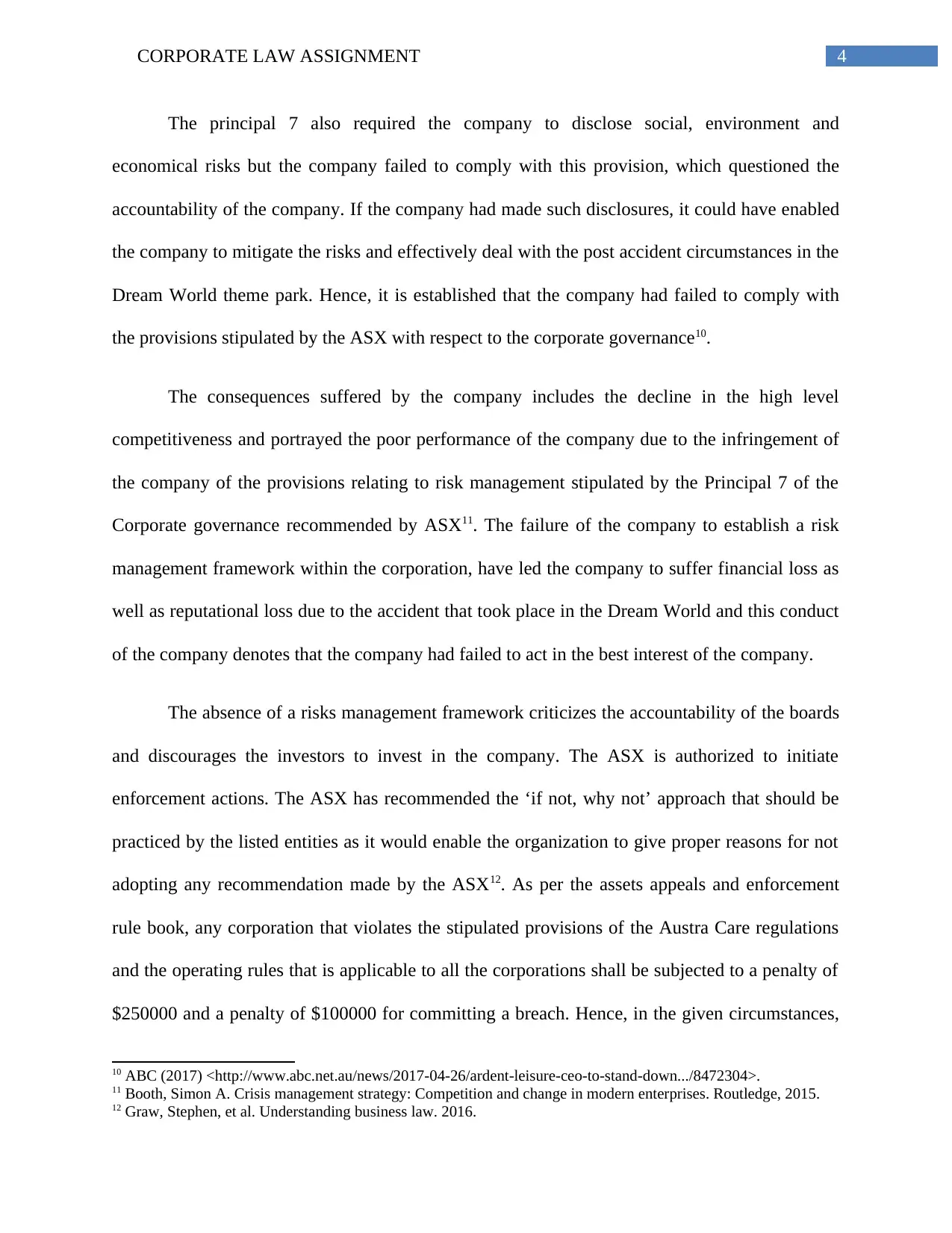
4CORPORATE LAW ASSIGNMENT
The principal 7 also required the company to disclose social, environment and
economical risks but the company failed to comply with this provision, which questioned the
accountability of the company. If the company had made such disclosures, it could have enabled
the company to mitigate the risks and effectively deal with the post accident circumstances in the
Dream World theme park. Hence, it is established that the company had failed to comply with
the provisions stipulated by the ASX with respect to the corporate governance10.
The consequences suffered by the company includes the decline in the high level
competitiveness and portrayed the poor performance of the company due to the infringement of
the company of the provisions relating to risk management stipulated by the Principal 7 of the
Corporate governance recommended by ASX11. The failure of the company to establish a risk
management framework within the corporation, have led the company to suffer financial loss as
well as reputational loss due to the accident that took place in the Dream World and this conduct
of the company denotes that the company had failed to act in the best interest of the company.
The absence of a risks management framework criticizes the accountability of the boards
and discourages the investors to invest in the company. The ASX is authorized to initiate
enforcement actions. The ASX has recommended the ‘if not, why not’ approach that should be
practiced by the listed entities as it would enable the organization to give proper reasons for not
adopting any recommendation made by the ASX12. As per the assets appeals and enforcement
rule book, any corporation that violates the stipulated provisions of the Austra Care regulations
and the operating rules that is applicable to all the corporations shall be subjected to a penalty of
$250000 and a penalty of $100000 for committing a breach. Hence, in the given circumstances,
10 ABC (2017) <http://www.abc.net.au/news/2017-04-26/ardent-leisure-ceo-to-stand-down.../8472304>.
11 Booth, Simon A. Crisis management strategy: Competition and change in modern enterprises. Routledge, 2015.
12 Graw, Stephen, et al. Understanding business law. 2016.
The principal 7 also required the company to disclose social, environment and
economical risks but the company failed to comply with this provision, which questioned the
accountability of the company. If the company had made such disclosures, it could have enabled
the company to mitigate the risks and effectively deal with the post accident circumstances in the
Dream World theme park. Hence, it is established that the company had failed to comply with
the provisions stipulated by the ASX with respect to the corporate governance10.
The consequences suffered by the company includes the decline in the high level
competitiveness and portrayed the poor performance of the company due to the infringement of
the company of the provisions relating to risk management stipulated by the Principal 7 of the
Corporate governance recommended by ASX11. The failure of the company to establish a risk
management framework within the corporation, have led the company to suffer financial loss as
well as reputational loss due to the accident that took place in the Dream World and this conduct
of the company denotes that the company had failed to act in the best interest of the company.
The absence of a risks management framework criticizes the accountability of the boards
and discourages the investors to invest in the company. The ASX is authorized to initiate
enforcement actions. The ASX has recommended the ‘if not, why not’ approach that should be
practiced by the listed entities as it would enable the organization to give proper reasons for not
adopting any recommendation made by the ASX12. As per the assets appeals and enforcement
rule book, any corporation that violates the stipulated provisions of the Austra Care regulations
and the operating rules that is applicable to all the corporations shall be subjected to a penalty of
$250000 and a penalty of $100000 for committing a breach. Hence, in the given circumstances,
10 ABC (2017) <http://www.abc.net.au/news/2017-04-26/ardent-leisure-ceo-to-stand-down.../8472304>.
11 Booth, Simon A. Crisis management strategy: Competition and change in modern enterprises. Routledge, 2015.
12 Graw, Stephen, et al. Understanding business law. 2016.
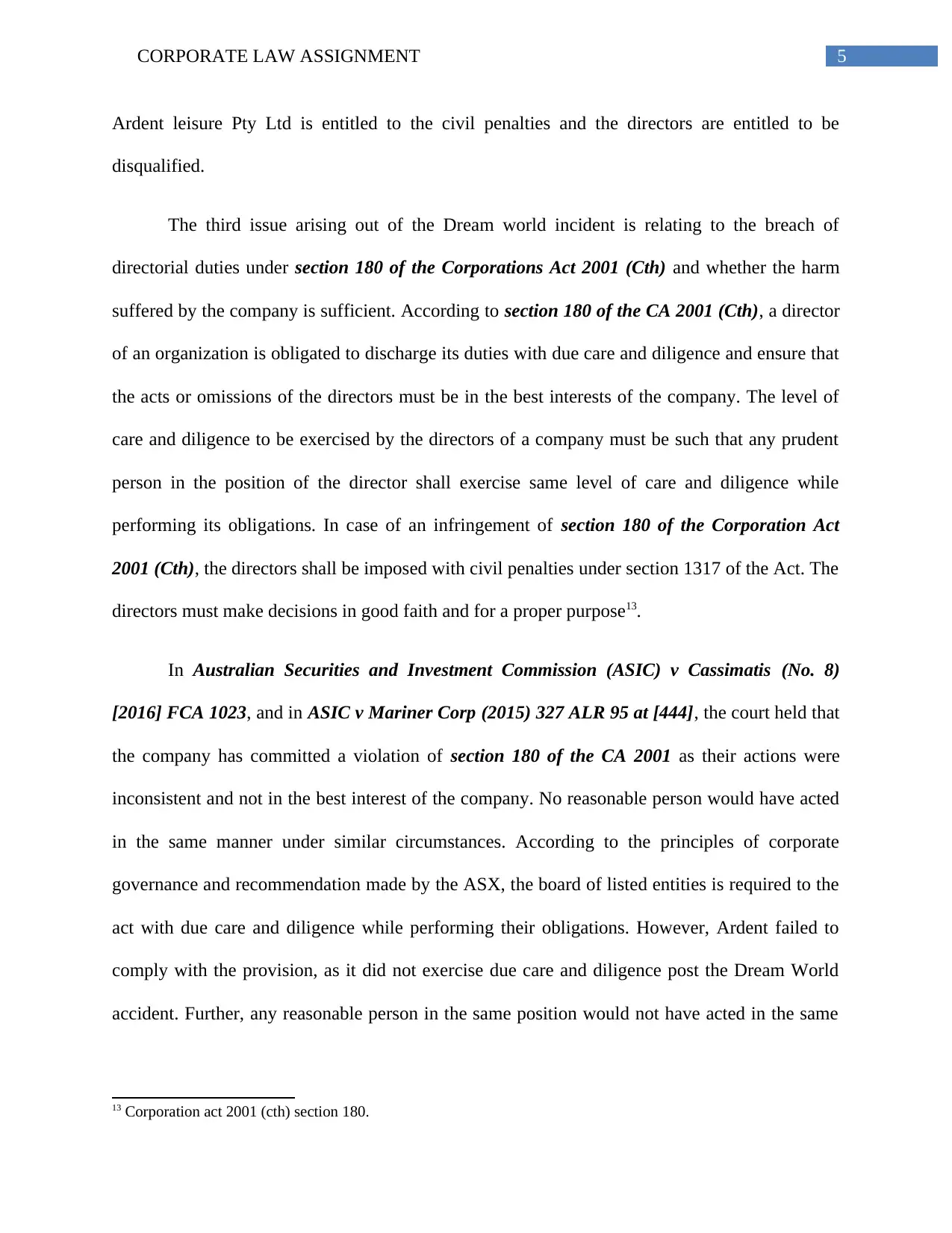
5CORPORATE LAW ASSIGNMENT
Ardent leisure Pty Ltd is entitled to the civil penalties and the directors are entitled to be
disqualified.
The third issue arising out of the Dream world incident is relating to the breach of
directorial duties under section 180 of the Corporations Act 2001 (Cth) and whether the harm
suffered by the company is sufficient. According to section 180 of the CA 2001 (Cth), a director
of an organization is obligated to discharge its duties with due care and diligence and ensure that
the acts or omissions of the directors must be in the best interests of the company. The level of
care and diligence to be exercised by the directors of a company must be such that any prudent
person in the position of the director shall exercise same level of care and diligence while
performing its obligations. In case of an infringement of section 180 of the Corporation Act
2001 (Cth), the directors shall be imposed with civil penalties under section 1317 of the Act. The
directors must make decisions in good faith and for a proper purpose13.
In Australian Securities and Investment Commission (ASIC) v Cassimatis (No. 8)
[2016] FCA 1023, and in ASIC v Mariner Corp (2015) 327 ALR 95 at [444], the court held that
the company has committed a violation of section 180 of the CA 2001 as their actions were
inconsistent and not in the best interest of the company. No reasonable person would have acted
in the same manner under similar circumstances. According to the principles of corporate
governance and recommendation made by the ASX, the board of listed entities is required to the
act with due care and diligence while performing their obligations. However, Ardent failed to
comply with the provision, as it did not exercise due care and diligence post the Dream World
accident. Further, any reasonable person in the same position would not have acted in the same
13 Corporation act 2001 (cth) section 180.
Ardent leisure Pty Ltd is entitled to the civil penalties and the directors are entitled to be
disqualified.
The third issue arising out of the Dream world incident is relating to the breach of
directorial duties under section 180 of the Corporations Act 2001 (Cth) and whether the harm
suffered by the company is sufficient. According to section 180 of the CA 2001 (Cth), a director
of an organization is obligated to discharge its duties with due care and diligence and ensure that
the acts or omissions of the directors must be in the best interests of the company. The level of
care and diligence to be exercised by the directors of a company must be such that any prudent
person in the position of the director shall exercise same level of care and diligence while
performing its obligations. In case of an infringement of section 180 of the Corporation Act
2001 (Cth), the directors shall be imposed with civil penalties under section 1317 of the Act. The
directors must make decisions in good faith and for a proper purpose13.
In Australian Securities and Investment Commission (ASIC) v Cassimatis (No. 8)
[2016] FCA 1023, and in ASIC v Mariner Corp (2015) 327 ALR 95 at [444], the court held that
the company has committed a violation of section 180 of the CA 2001 as their actions were
inconsistent and not in the best interest of the company. No reasonable person would have acted
in the same manner under similar circumstances. According to the principles of corporate
governance and recommendation made by the ASX, the board of listed entities is required to the
act with due care and diligence while performing their obligations. However, Ardent failed to
comply with the provision, as it did not exercise due care and diligence post the Dream World
accident. Further, any reasonable person in the same position would not have acted in the same
13 Corporation act 2001 (cth) section 180.
⊘ This is a preview!⊘
Do you want full access?
Subscribe today to unlock all pages.

Trusted by 1+ million students worldwide
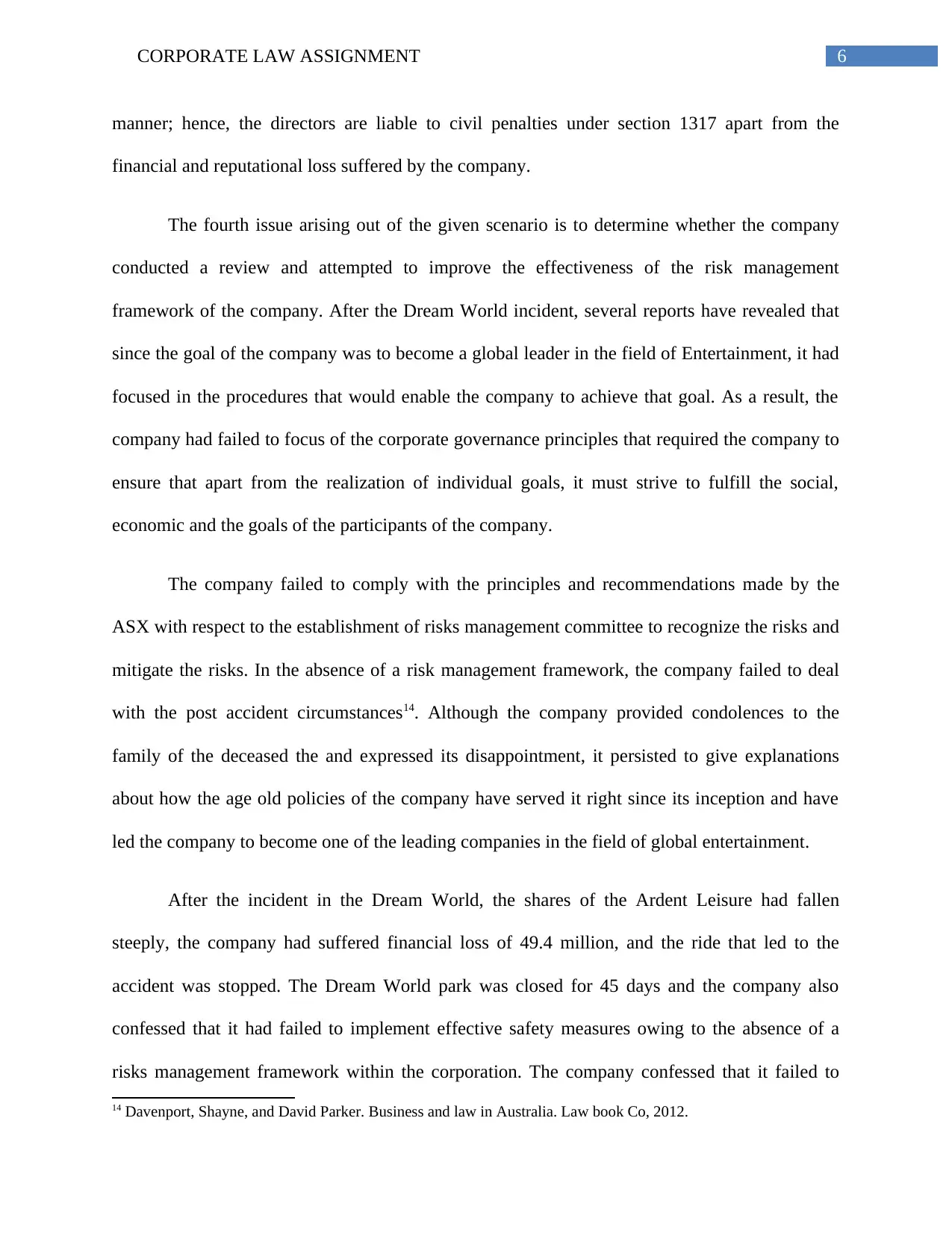
6CORPORATE LAW ASSIGNMENT
manner; hence, the directors are liable to civil penalties under section 1317 apart from the
financial and reputational loss suffered by the company.
The fourth issue arising out of the given scenario is to determine whether the company
conducted a review and attempted to improve the effectiveness of the risk management
framework of the company. After the Dream World incident, several reports have revealed that
since the goal of the company was to become a global leader in the field of Entertainment, it had
focused in the procedures that would enable the company to achieve that goal. As a result, the
company had failed to focus of the corporate governance principles that required the company to
ensure that apart from the realization of individual goals, it must strive to fulfill the social,
economic and the goals of the participants of the company.
The company failed to comply with the principles and recommendations made by the
ASX with respect to the establishment of risks management committee to recognize the risks and
mitigate the risks. In the absence of a risk management framework, the company failed to deal
with the post accident circumstances14. Although the company provided condolences to the
family of the deceased the and expressed its disappointment, it persisted to give explanations
about how the age old policies of the company have served it right since its inception and have
led the company to become one of the leading companies in the field of global entertainment.
After the incident in the Dream World, the shares of the Ardent Leisure had fallen
steeply, the company had suffered financial loss of 49.4 million, and the ride that led to the
accident was stopped. The Dream World park was closed for 45 days and the company also
confessed that it had failed to implement effective safety measures owing to the absence of a
risks management framework within the corporation. The company confessed that it failed to
14 Davenport, Shayne, and David Parker. Business and law in Australia. Law book Co, 2012.
manner; hence, the directors are liable to civil penalties under section 1317 apart from the
financial and reputational loss suffered by the company.
The fourth issue arising out of the given scenario is to determine whether the company
conducted a review and attempted to improve the effectiveness of the risk management
framework of the company. After the Dream World incident, several reports have revealed that
since the goal of the company was to become a global leader in the field of Entertainment, it had
focused in the procedures that would enable the company to achieve that goal. As a result, the
company had failed to focus of the corporate governance principles that required the company to
ensure that apart from the realization of individual goals, it must strive to fulfill the social,
economic and the goals of the participants of the company.
The company failed to comply with the principles and recommendations made by the
ASX with respect to the establishment of risks management committee to recognize the risks and
mitigate the risks. In the absence of a risk management framework, the company failed to deal
with the post accident circumstances14. Although the company provided condolences to the
family of the deceased the and expressed its disappointment, it persisted to give explanations
about how the age old policies of the company have served it right since its inception and have
led the company to become one of the leading companies in the field of global entertainment.
After the incident in the Dream World, the shares of the Ardent Leisure had fallen
steeply, the company had suffered financial loss of 49.4 million, and the ride that led to the
accident was stopped. The Dream World park was closed for 45 days and the company also
confessed that it had failed to implement effective safety measures owing to the absence of a
risks management framework within the corporation. The company confessed that it failed to
14 Davenport, Shayne, and David Parker. Business and law in Australia. Law book Co, 2012.
Paraphrase This Document
Need a fresh take? Get an instant paraphrase of this document with our AI Paraphraser
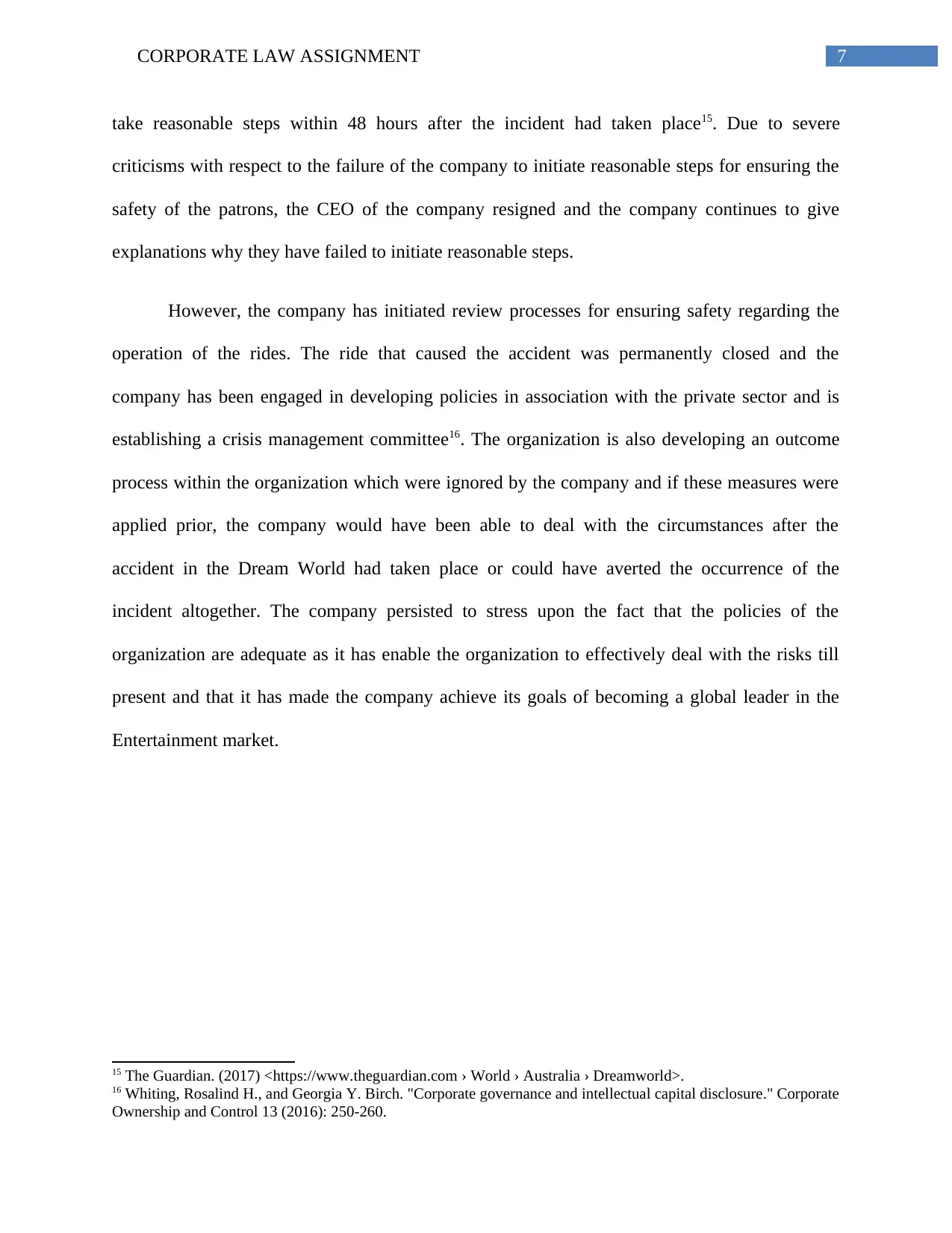
7CORPORATE LAW ASSIGNMENT
take reasonable steps within 48 hours after the incident had taken place15. Due to severe
criticisms with respect to the failure of the company to initiate reasonable steps for ensuring the
safety of the patrons, the CEO of the company resigned and the company continues to give
explanations why they have failed to initiate reasonable steps.
However, the company has initiated review processes for ensuring safety regarding the
operation of the rides. The ride that caused the accident was permanently closed and the
company has been engaged in developing policies in association with the private sector and is
establishing a crisis management committee16. The organization is also developing an outcome
process within the organization which were ignored by the company and if these measures were
applied prior, the company would have been able to deal with the circumstances after the
accident in the Dream World had taken place or could have averted the occurrence of the
incident altogether. The company persisted to stress upon the fact that the policies of the
organization are adequate as it has enable the organization to effectively deal with the risks till
present and that it has made the company achieve its goals of becoming a global leader in the
Entertainment market.
15 The Guardian. (2017) <https://www.theguardian.com › World › Australia › Dreamworld>.
16 Whiting, Rosalind H., and Georgia Y. Birch. "Corporate governance and intellectual capital disclosure." Corporate
Ownership and Control 13 (2016): 250-260.
take reasonable steps within 48 hours after the incident had taken place15. Due to severe
criticisms with respect to the failure of the company to initiate reasonable steps for ensuring the
safety of the patrons, the CEO of the company resigned and the company continues to give
explanations why they have failed to initiate reasonable steps.
However, the company has initiated review processes for ensuring safety regarding the
operation of the rides. The ride that caused the accident was permanently closed and the
company has been engaged in developing policies in association with the private sector and is
establishing a crisis management committee16. The organization is also developing an outcome
process within the organization which were ignored by the company and if these measures were
applied prior, the company would have been able to deal with the circumstances after the
accident in the Dream World had taken place or could have averted the occurrence of the
incident altogether. The company persisted to stress upon the fact that the policies of the
organization are adequate as it has enable the organization to effectively deal with the risks till
present and that it has made the company achieve its goals of becoming a global leader in the
Entertainment market.
15 The Guardian. (2017) <https://www.theguardian.com › World › Australia › Dreamworld>.
16 Whiting, Rosalind H., and Georgia Y. Birch. "Corporate governance and intellectual capital disclosure." Corporate
Ownership and Control 13 (2016): 250-260.
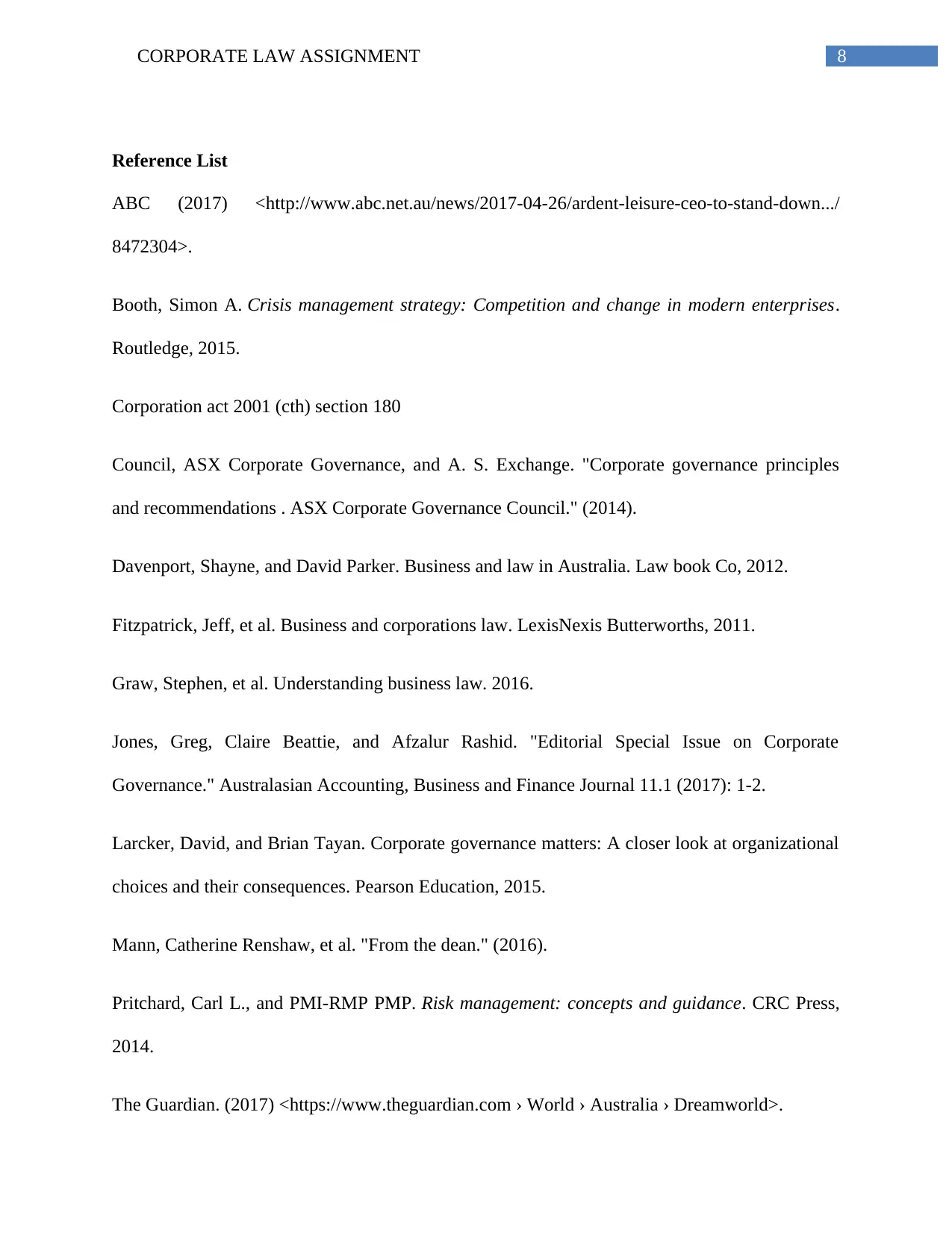
8CORPORATE LAW ASSIGNMENT
Reference List
ABC (2017) <http://www.abc.net.au/news/2017-04-26/ardent-leisure-ceo-to-stand-down.../
8472304>.
Booth, Simon A. Crisis management strategy: Competition and change in modern enterprises.
Routledge, 2015.
Corporation act 2001 (cth) section 180
Council, ASX Corporate Governance, and A. S. Exchange. "Corporate governance principles
and recommendations . ASX Corporate Governance Council." (2014).
Davenport, Shayne, and David Parker. Business and law in Australia. Law book Co, 2012.
Fitzpatrick, Jeff, et al. Business and corporations law. LexisNexis Butterworths, 2011.
Graw, Stephen, et al. Understanding business law. 2016.
Jones, Greg, Claire Beattie, and Afzalur Rashid. "Editorial Special Issue on Corporate
Governance." Australasian Accounting, Business and Finance Journal 11.1 (2017): 1-2.
Larcker, David, and Brian Tayan. Corporate governance matters: A closer look at organizational
choices and their consequences. Pearson Education, 2015.
Mann, Catherine Renshaw, et al. "From the dean." (2016).
Pritchard, Carl L., and PMI-RMP PMP. Risk management: concepts and guidance. CRC Press,
2014.
The Guardian. (2017) <https://www.theguardian.com › World › Australia › Dreamworld>.
Reference List
ABC (2017) <http://www.abc.net.au/news/2017-04-26/ardent-leisure-ceo-to-stand-down.../
8472304>.
Booth, Simon A. Crisis management strategy: Competition and change in modern enterprises.
Routledge, 2015.
Corporation act 2001 (cth) section 180
Council, ASX Corporate Governance, and A. S. Exchange. "Corporate governance principles
and recommendations . ASX Corporate Governance Council." (2014).
Davenport, Shayne, and David Parker. Business and law in Australia. Law book Co, 2012.
Fitzpatrick, Jeff, et al. Business and corporations law. LexisNexis Butterworths, 2011.
Graw, Stephen, et al. Understanding business law. 2016.
Jones, Greg, Claire Beattie, and Afzalur Rashid. "Editorial Special Issue on Corporate
Governance." Australasian Accounting, Business and Finance Journal 11.1 (2017): 1-2.
Larcker, David, and Brian Tayan. Corporate governance matters: A closer look at organizational
choices and their consequences. Pearson Education, 2015.
Mann, Catherine Renshaw, et al. "From the dean." (2016).
Pritchard, Carl L., and PMI-RMP PMP. Risk management: concepts and guidance. CRC Press,
2014.
The Guardian. (2017) <https://www.theguardian.com › World › Australia › Dreamworld>.
⊘ This is a preview!⊘
Do you want full access?
Subscribe today to unlock all pages.

Trusted by 1+ million students worldwide
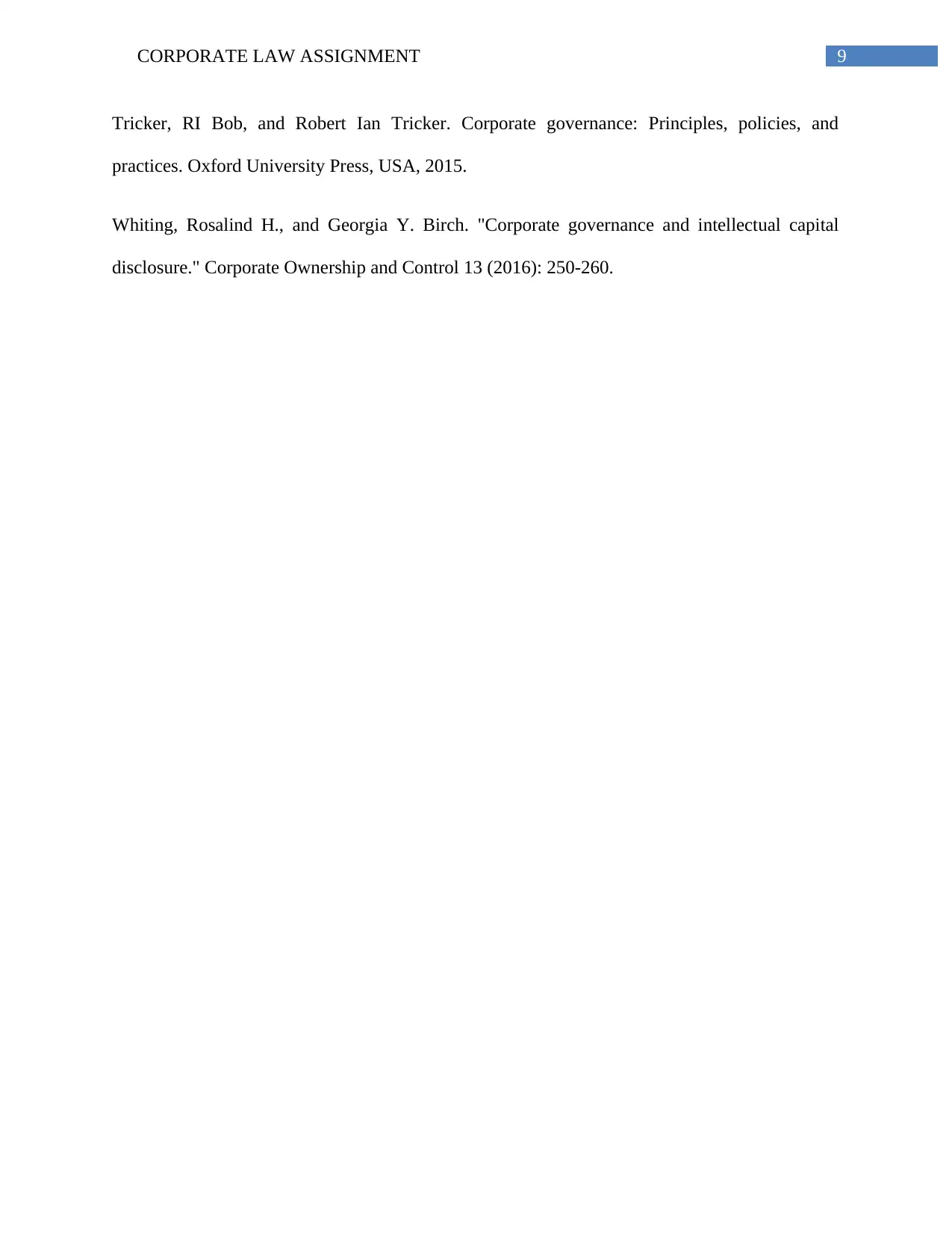
9CORPORATE LAW ASSIGNMENT
Tricker, RI Bob, and Robert Ian Tricker. Corporate governance: Principles, policies, and
practices. Oxford University Press, USA, 2015.
Whiting, Rosalind H., and Georgia Y. Birch. "Corporate governance and intellectual capital
disclosure." Corporate Ownership and Control 13 (2016): 250-260.
Tricker, RI Bob, and Robert Ian Tricker. Corporate governance: Principles, policies, and
practices. Oxford University Press, USA, 2015.
Whiting, Rosalind H., and Georgia Y. Birch. "Corporate governance and intellectual capital
disclosure." Corporate Ownership and Control 13 (2016): 250-260.
1 out of 10
Related Documents
Your All-in-One AI-Powered Toolkit for Academic Success.
+13062052269
info@desklib.com
Available 24*7 on WhatsApp / Email
![[object Object]](/_next/static/media/star-bottom.7253800d.svg)
Unlock your academic potential
Copyright © 2020–2025 A2Z Services. All Rights Reserved. Developed and managed by ZUCOL.




